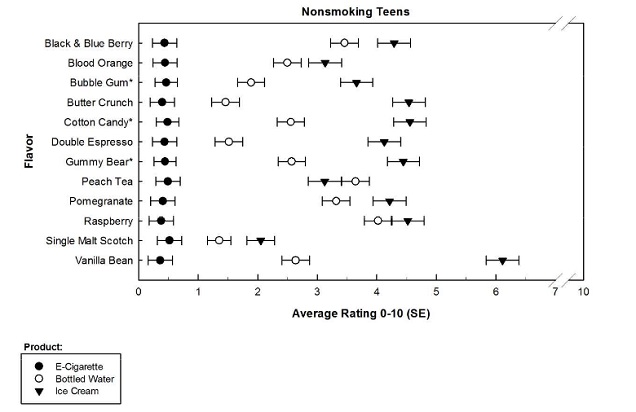
We’ve all heard the argument. Because e-cigarettes are available in flavors like bubblegum, gummy bear and [insert appealing-sounding flavor name here], they will hook unsuspecting children into nicotine addiction, and then the otherwise innocent youths might progress to smoking and die of lung cancer. The implication is that it’s the flavors themselves that tempt non-smoking youth into trying e-cigarettes, when they’d otherwise be completely nicotine-free.
The standard response to this would be that while e-cig flavors will appeal to some teens, the primary appeal of vaping itself is to adult smokers, and the flavors simply make it more enjoyable. A new study has attempted to settle the flavor debate, and found that flavors don’t attract non-smoking teens to e-cigarettes. However, it’s sponsored by NJOY, and it seems to run contrary to expectation – although the evidence shows that only low numbers of non-smoking teens try e-cigarettes, you’d still generally imagine that some flavors would make it more appealing. So, is the result too good to be true?
Summary
- 216 non-smoking teens and 432 adult smokers were surveyed about their interest in trying e-cigs, flavored water and ice cream in specific flavors, ranking interest from 0 to 10.
- Adult smokers were more interested in trying e-cigs than non-smoking teens, but both groups had limited interest.
- Interest in trying e-cigs varied significantly according to flavor for adult smokers, but not for non-smoking teens. For teens, the average interest score was 0.41/10, and the most appealing flavor (scotch) only scored an average of 0.52/10.
- Teens were much more interested in the same flavors in the form of ice cream or water, suggesting that the product affects overall interest more than the flavor.
- Adults who’d vaped recently were most interested in flavors, and showed most variation in interest in vaping according to flavor.
- Only non-smoking teens who hadn’t tried vaping were included in the study, so flavors could make a bigger difference for non-smokers who have tried or are interested in vaping, or teen smokers.
- Overall, the study effectively refutes the idea that specific flavors attract non-smoking teens to vaping.
What They Did – Comparing Adults’ and Teens’ Interest in E-Cigarette Flavors
The survey drew participants from an online research panel, and compared a sample of teen non-smokers with adult smokers (full paper is paywalled). The non-smoking teens (average age of 16) hadn’t used any tobacco product in the last 6 months and had never tried e-cigs; they could have smoked a cigarette before, but only 8 of the 216 non-smoking teens had done so. Of the 432 adult smokers recruited, the majority (81 percent) were daily smokers, with the remainder being occasional smokers. The adults could have tried e-cigarettes: about 35 percent had tried one but not vaped in the past month and just under 22 percent had vaped in the past month.
The protocol was fairly straightforward. The participants were presented with a combination of a product and a flavor description, and asked to rank their interest in trying the flavored product from 0 to 10. Flavors were the main focus, so there was no branding or other advertising content aside from the description of the flavor. The different products were e-cigarettes, bottled water and ice cream, and flavors were taken from all three types of product and then randomly re-combined. Each participant was shown 24 combinations – for example, “would you be interested in trying a cotton candy flavored e-cigarette?” or “would you be interested in trying raspberry flavored ice cream?” – enabling the researchers to work out if flavors made e-cigarettes more appealing, or whether the flavors were only appealing presented in the form of ice cream or water.
The e-cigarette flavors were either currently offered by NJOY or ones they’re considering to offer in the future (cue accusations that they’re doing big-tobacco-style market research to work out which flavors can more effectively hook teens), with 15 e-cig flavors in total. These included bubble gum, cotton candy and gummy bear (commonly used as examples of e-cig companies marketing to children), but also others like single malt scotch, classic tobacco and peach tea. The e-cig flavors were the main focus of the study, but other flavors were included in each participant’s questions, and the screening questionnaire asked about flavored bottled water and ice cream use too so the intent wasn’t clear to respondents.
What They Found – E-Cig Flavors Appeal to Adult Smokers, Not Non-Smoking Teens
The core finding was that (as you would expect) e-cigarettes generally held significantly more appeal for adult smokers than teen non-smokers, regardless of flavor. The interest in trying e-cigarettes was ultimately low, with a mean score (on the 0 to 10 scale) of 1.73 for adult smokers and 0.41 for non-smoking teens. For the adults, their scores varied much more depending on flavor than the teens’ did, with the average score ranging from 1.01 to 3.49 (least for scotch and most for classic tobacco) compared to between 0.16 and 0.52 (least for dark tobacco and most for scotch) for the non-smoking teens. In short, the flavor mattered much more for adults but made little difference for teens.

For gummy bear, cotton candy and bubble gum, the results were distinctly unimpressive for the non-smoking teens, with cotton candy being the most appealing but still less so than classic tobacco or single malt scotch. Keep in mind, though, that the actual “interest” was still tiny – a maximum of 0.52 on a 0 to 10 scale where 0 indicates no interest at all.
When the same flavors (barring the tobacco options) were attached to ice cream or bottled water, the interest from both the smoking adults and non-smoking teens was much higher than it was for e-cigs. The teens’ average rating for the flavors in the form of water increased to 2.58 and for ice cream it rose to 4.06, higher than the corresponding adult ratings. When the flavors weren’t attached to e-cigarettes, teens’ interest varied significantly according to the specific flavor asked about. This strongly suggests teen interest is more about the product the flavor is associated with than the flavor itself: a teen won’t mindlessly try e-cigs just because it’s gummy bear flavor, but it might make a difference for an ice cream.

Since the adult smokers could have tried e-cigarettes, researchers also analyzed the results for them according to vaping history. Unsurprisingly, the adult smokers who’d tried e-cigarettes were more interested in flavored e-cigarettes than those who hadn’t. The recent users were both most interested in e-cigs overall and showed more difference in interest according to flavor. Generally, classic tobacco and menthol were the most appealing, but more recent vaping made interest in non-cigarette flavors higher.
Is it Too Good to Be True?
The finding is admittedly a good thing for e-cigarette advocates, but the somewhat unexpected result – in combination with the conflicting interests of the funding source – means we should be cautious about drawing firm conclusions. The most obvious issue is the fact that non-smoking teens were compared with smoking adults, rather than smoking (or vaping) teens or non-smoking adults. The groups were quite different from one another, in short, pitting the group most likely to be interested against the one least likely to be interested.
That said, the point of the study was to look at the impact the flavor had on non-smoking teens’ interest, looking to address the specific nightmare scenario of a kid who otherwise wouldn’t have smoked being tempted into vaping by flavor descriptions. Those already more interested in vaping (and the seven teens who were excluded because they’d already tried vaping) might show more variation in interest with flavor, but the core point is that this appears to be related to a pre-existing interest in trying vaping, rather than the flavor itself making vaping appealing where it otherwise wouldn’t have been. Basically, the study can’t say flavors don’t make a difference for any teens, but it does a pretty good job of showing that the interest in vaping isn’t created by specific flavors – if it were, bubblegum, for example, would have produced markedly higher scores than tobacco or menthol, but it didn’t.
Conclusion – E-Cig Flavors Don’t Push Teens into Addiction
So the findings might not generalize to all teens (like non-smokers who’ve tried vaping or are interested in smoking), but do specifically refute the core argument about the impact of e-cigarette flavors. If you have a non-smoking teen, he or she is very unlikely to care what flavors e-cigarettes come in, and isn’t going to try one just because of a “cotton candy” e-liquid. So, the nightmare scenario familiar from anti-vaping arguments has evidence against pretty much every stage: flavors tempt otherwise non-smoking teens into vaping (this study says probably not), large numbers of non-smoker start vaping (many studies say they aren’t) and then transition to smoking (the studies addressing this to date indicate that they almost definitely won’t). We’ll still see the argument, of course, but it’s getting easier and easier to refute the claims with hard data.

